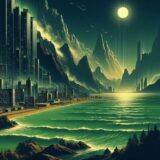First, lets start with a little background on how I discovered the story The Invasion by Robert Willey (“discovered” may not be the most appropriate word, but it does express how I felt reading it). Last week, we looked at the non-fiction book Rockets and Missiles: Past and Future from the 50’s about the evolution and technology of early rocketry. Hidden within those pages, we confirmed that science fiction was one of the driving forces behind the theory of space flight and how many of the genre writers of the time helped push the idea to reality.
One of the most influential participants in this amazing drive to space exploration was Willy Ley of the German Rocket Society. His models and research on rocketry, orbital trajectories and spaceflight were so precise, Nazi Germany’s Gestapo confiscated his work a couple years after Ley had fled the country. Not surprising, the historic technological facility Peenemünde Army Research Center in Germany opened shortly after in 1937. This military proving ground provided a home for some of the most prominent pioneers of rocket science.

Why this history lesson? The fandom of science fiction may not know Willy Ley. They may be more familiar with his literary passion through his work under the pen name of Robert Willey. Willey’s short story The Invasion was first published in the September 1940 issue of Super Science Stories. Later, the story appeared in various editions of the anthology known as The Expert Dreamers before finally finding a place in the Scholastic Book Services anthology titled Beyond Belief (the 1966 source of this review).
The Invasion by Robert Willey begins in the midst of a massive armament of military weapons standing ready, waiting in pouring rain for the word from high command to open fire. The setting is a national forest, but that’s all we need to know. The imagery is so precise and vibrant with detail, the reader is immediately swept back to the days of WWII. Granted The Invasion was written during the same time period, any avid historian will appreciate the intense emotion brought to life in this narrative.
“Walter Harling watched the soldiers as they fed a clip of long and dangerous looking cartridges into the magazines of the antiaircraft gun. The thin, multiple barrels pointed almost vertical into the air and toward the foliage of large and beautiful trees that hid them from sight of the enemy aircraft. At their muzzles these long barrels carried clumsy-looking drumlike contraptions, Schneider recoil brakes that diverted the flow of the gases resulting from the explosion of the cartridges in such a way that counter-recoil balanced original recoil and held the guns steady.”

With this kind of opening paragraph, and if you’re like me, it would be difficult for most readers to just stop right there. I could not find an available copy of the stand alone story on-line, but used copies of the book Beyond Belief are still available for purchase from other sources.
Not surprising, Willey’s attention to detail does not falter when The Invasion turns to the more fantastic elements of science fiction. The author uses his vast experience and knowledge of rocket designs to describe what he imagines an “enemy aircraft” would look like. The three alien vessels in the story are first confused for dirigibles, which makes sense since they possessed “nothing that might support or propel” the elongated teardrop shaped alien ships. This stretch from the known sciences of flight along with the seemingly indestructible nature of these aliens is part of what makes this a fulfilling story of man verses the unknown.
Seeing troops going up against a formidable foe is disturbing enough, which also gives credence to the science fiction factor. Yet, it is probably how many soldiers might have viewed a powerful enemy weapon on the battlefield for the very first time. Being a man with his mind continually focused on the future, Willey must have panged at the advancements in warfare and at those to surely come. Intentional or not, The Invasion is both a symbol of the dramatic state of the time as well as an entertaining escape from reality.
Whether you call him Robert Willey or Willy Ley, the guy knew his science (and I don’t mean in a coyote with a jetpack kind of way). He knew how to write fantastic science fiction too. The Invasion not only takes us back to the era of a war torn United States fighting the good fight, the story also opens the reader’s mind to some of the most fantastic speculations in space travel of the period. The fact that this review is based on an anthology produced by a publisher known for educational materials, I might say there is still hope for the permanence and growth of science fiction fans. But the other little fact that this edition is almost a decade old, it makes the call for these reviews, reminders and history lessons that much more important.










